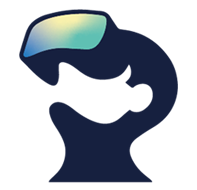As I mentioned in the introduction, body movement is a natural human behavior. People use body movement to transport, interact and communicate. You control your muscles to walk on the street or craw on your king-size bed with your arm and hands. You get your delivery from the Uber Eats driver and lift it with your hands. You wave your hands to your friend when you meet him to make greetings. You turn your head right to see if anyone wants to bother you working on your project on the desk. All these behaviors in the real world cannot be done without moving our bodies, so it is easy to infer that we have similar interaction in the virtual reality.
Alger introduced a diagram indicating the content zone of a virtual reality space. (2015) There is a range of comfortable content zone, and the angle shows the angle that our heads can naturally rotate in the virtual space. It is very similar to our head actions in the real world. Alter mentions that the “curiosity zone” can be only reached by rotating their body, so it defines the space where the user interface in virtual reality should be placed.
(https://miro.medium.com/max/2800/1*07fEZmJ7JVAwa9TExmjtKw.png)
Secondly, people are not always moving heavily except for doing gymnastics, so the body movement should not be strenuous. We need to consider the weight of devices because if devices are wearable, they add weight to our body parts. As a result, it will be easy to get tired. Imagine you are laying on the bed and you want to watch YouTube with your phone, so you will hold it with your hand. 5 minutes later, you get tired and it stops you continue watching as a result. You will not like holding a device for a long time. Devices should be designed as light as possible.
Microsoft’s Kinect captures body movement with a camera, and it’s a great inspiration for virtual reality body movement capture because it has no wearable devices at all. The only problem virtual reality needs to solve is to map body parts in a limited or unlimited virtual space. In the next section, we will introduce some existing devices that support body movement capture and speculations.
(http://nextgenclassic.com/wp-content/uploads/2017/05/VRKinectTracking.jpg)
